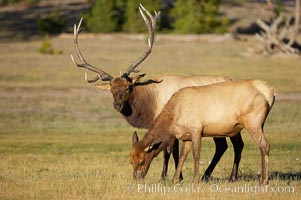
Bull elk, with large antlers, alongside female elk during rutting season, autumn. A bull will defend his harem of 20 cows or more from competing bulls and predators. Only mature bulls have large harems and breeding success peaks at about eight years of age. Bulls between two to four years and over 11 years of age rarely have harems, and spend most of the rut on the periphery of larger harems. Young and old bulls that do acquire a harem hold it later in the breeding season than do bulls in their prime. A bull with a harem rarely feeds and he may lose up to 20 percent of his body weight while he is guarding the harem.
Species: Elk, Cervus canadensis
Location: Yellowstone National Park, Wyoming
Image ID: 19696
Species: Elk, Cervus canadensis
Location: Yellowstone National Park, Wyoming
Image ID: 19696

Male elk bugling during the fall rut. Large male elk are known as bulls. Male elk have large antlers which are shed each year. Male elk engage in competitive mating behaviors during the rut, including posturing, antler wrestling and bugling, a loud series of screams which is intended to establish dominance over other males and attract females.
Species: Elk, Cervus canadensis
Location: Mammoth Hot Springs, Yellowstone National Park, Wyoming
Image ID: 19705
Species: Elk, Cervus canadensis
Location: Mammoth Hot Springs, Yellowstone National Park, Wyoming
Image ID: 19705
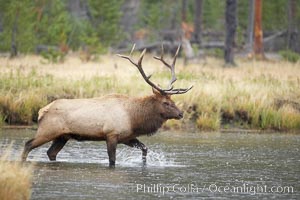
Male elk bugling during the fall rut. Large male elk are known as bulls. Male elk have large antlers which are shed each year. Male elk engage in competitive mating behaviors during the rut, including posturing, antler wrestling and bugling, a loud series of screams which is intended to establish dominance over other males and attract females.
Species: Elk, Cervus canadensis
Location: Madison River, Yellowstone National Park, Wyoming
Image ID: 19711
Species: Elk, Cervus canadensis
Location: Madison River, Yellowstone National Park, Wyoming
Image ID: 19711

Bull elk in sage brush with large rack of antlers during the fall rut (mating season). This bull elk has sparred with other bulls to establish his harem of females with which he hopes to mate.
Species: Elk, Cervus canadensis
Location: Mammoth Hot Springs, Yellowstone National Park, Wyoming
Image ID: 19726
Species: Elk, Cervus canadensis
Location: Mammoth Hot Springs, Yellowstone National Park, Wyoming
Image ID: 19726

Juvenile elk, autumn.
Species: Elk, Cervus canadensis
Location: Yellowstone National Park, Wyoming
Image ID: 19727
Species: Elk, Cervus canadensis
Location: Yellowstone National Park, Wyoming
Image ID: 19727
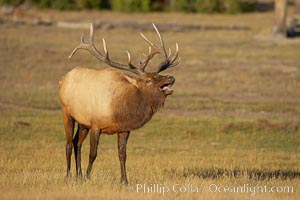
Male elk bugling during the fall rut. Large male elk are known as bulls. Male elk have large antlers which are shed each year. Male elk engage in competitive mating behaviors during the rut, including posturing, antler wrestling and bugling, a loud series of screams which is intended to establish dominance over other males and attract females.
Species: Elk, Cervus canadensis
Location: Yellowstone National Park, Wyoming
Image ID: 19729
Species: Elk, Cervus canadensis
Location: Yellowstone National Park, Wyoming
Image ID: 19729

Male elk bugling during the fall rut. Large male elk are known as bulls. Male elk have large antlers which are shed each year. Male elk engage in competitive mating behaviors during the rut, including posturing, antler wrestling and bugling, a loud series of screams which is intended to establish dominance over other males and attract females.
Species: Elk, Cervus canadensis
Location: Yellowstone National Park, Wyoming
Image ID: 19731
Species: Elk, Cervus canadensis
Location: Yellowstone National Park, Wyoming
Image ID: 19731
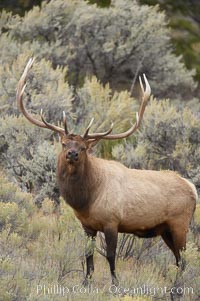
Bull elk in sage brush with large rack of antlers during the fall rut (mating season). This bull elk has sparred with other bulls to establish his harem of females with which he hopes to mate.
Species: Elk, Cervus canadensis
Location: Mammoth Hot Springs, Yellowstone National Park, Wyoming
Image ID: 19735
Species: Elk, Cervus canadensis
Location: Mammoth Hot Springs, Yellowstone National Park, Wyoming
Image ID: 19735
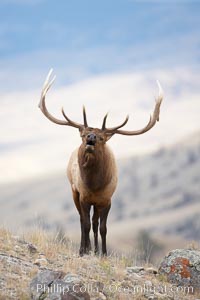
Male elk bugling during the fall rut. Large male elk are known as bulls. Male elk have large antlers which are shed each year. Male elk engage in competitive mating behaviors during the rut, including posturing, antler wrestling and bugling, a loud series of screams which is intended to establish dominance over other males and attract females.
Species: Elk, Cervus canadensis
Location: Mammoth Hot Springs, Yellowstone National Park, Wyoming
Image ID: 19736
Species: Elk, Cervus canadensis
Location: Mammoth Hot Springs, Yellowstone National Park, Wyoming
Image ID: 19736
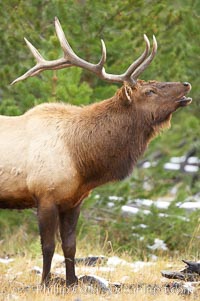
Male elk bugling during the fall rut. Large male elk are known as bulls. Male elk have large antlers which are shed each year. Male elk engage in competitive mating behaviors during the rut, including posturing, antler wrestling and bugling, a loud series of screams which is intended to establish dominance over other males and attract females.
Species: Elk, Cervus canadensis
Location: Yellowstone National Park, Wyoming
Image ID: 19737
Species: Elk, Cervus canadensis
Location: Yellowstone National Park, Wyoming
Image ID: 19737

Elk, bull elk, adult male elk with large set of antlers. By September, this bull elk's antlers have reached their full size and the velvet has fallen off. This bull elk has sparred with other bulls for access to herds of females in estrous and ready to mate.
Species: Elk, Cervus canadensis
Location: Yellowstone National Park, Wyoming
Image ID: 19739
Species: Elk, Cervus canadensis
Location: Yellowstone National Park, Wyoming
Image ID: 19739

Bull elk in sage brush with large rack of antlers during the fall rut (mating season). This bull elk has sparred with other bulls to establish his harem of females with which he hopes to mate.
Species: Elk, Cervus canadensis
Location: Mammoth Hot Springs, Yellowstone National Park, Wyoming
Image ID: 19744
Species: Elk, Cervus canadensis
Location: Mammoth Hot Springs, Yellowstone National Park, Wyoming
Image ID: 19744

Bull elk in sage brush with large rack of antlers during the fall rut (mating season). This bull elk has sparred with other bulls to establish his harem of females with which he hopes to mate.
Species: Elk, Cervus canadensis
Location: Mammoth Hot Springs, Yellowstone National Park, Wyoming
Image ID: 19745
Species: Elk, Cervus canadensis
Location: Mammoth Hot Springs, Yellowstone National Park, Wyoming
Image ID: 19745

Elk, bull elk, adult male elk with large set of antlers. By September, this bull elk's antlers have reached their full size and the velvet has fallen off. This bull elk has sparred with other bulls for access to herds of females in estrous and ready to mate.
Species: Elk, Cervus canadensis
Location: Yellowstone National Park, Wyoming
Image ID: 19747
Species: Elk, Cervus canadensis
Location: Yellowstone National Park, Wyoming
Image ID: 19747

Large male elk (bull) in snow covered meadow near Madison River. Only male elk have antlers, which start growing in the spring and are shed each winter. The largest antlers may be 4 feet long and weigh up to 40 pounds. Antlers are made of bone which can grow up to one inch per day. While growing, the antlers are covered with and protected by a soft layer of highly vascularised skin known as velvet. The velvet is shed in the summer when the antlers have fully developed. Bull elk may have six or more tines on each antler, however the number of tines has little to do with the age or maturity of a particular animal.
Species: Elk, Cervus canadensis
Location: Yellowstone National Park, Wyoming
Image ID: 19749
Species: Elk, Cervus canadensis
Location: Yellowstone National Park, Wyoming
Image ID: 19749
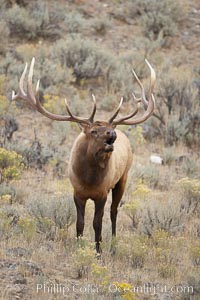
Male elk bugling during the fall rut. Large male elk are known as bulls. Male elk have large antlers which are shed each year. Male elk engage in competitive mating behaviors during the rut, including posturing, antler wrestling and bugling, a loud series of screams which is intended to establish dominance over other males and attract females.
Species: Elk, Cervus canadensis
Location: Mammoth Hot Springs, Yellowstone National Park, Wyoming
Image ID: 19750
Species: Elk, Cervus canadensis
Location: Mammoth Hot Springs, Yellowstone National Park, Wyoming
Image ID: 19750

Small group of female and juvenile elk.
Species: Elk, Cervus canadensis
Location: Mammoth Hot Springs, Yellowstone National Park, Wyoming
Image ID: 19758
Species: Elk, Cervus canadensis
Location: Mammoth Hot Springs, Yellowstone National Park, Wyoming
Image ID: 19758
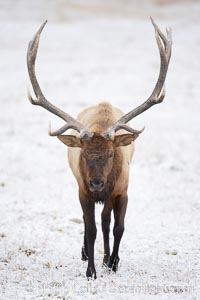
Large male elk (bull) in snow covered meadow near Madison River. Only male elk have antlers, which start growing in the spring and are shed each winter. The largest antlers may be 4 feet long and weigh up to 40 pounds. Antlers are made of bone which can grow up to one inch per day. While growing, the antlers are covered with and protected by a soft layer of highly vascularised skin known as velvet. The velvet is shed in the summer when the antlers have fully developed. Bull elk may have six or more tines on each antler, however the number of tines has little to do with the age or maturity of a particular animal.
Species: Elk, Cervus canadensis
Location: Yellowstone National Park, Wyoming
Image ID: 19767
Species: Elk, Cervus canadensis
Location: Yellowstone National Park, Wyoming
Image ID: 19767

Elk, bull elk, adult male elk with large set of antlers. By September, this bull elk's antlers have reached their full size and the velvet has fallen off. This bull elk has sparred with other bulls for access to herds of females in estrous and ready to mate.
Species: Elk, Cervus canadensis
Location: Yellowstone National Park, Wyoming
Image ID: 19773
Species: Elk, Cervus canadensis
Location: Yellowstone National Park, Wyoming
Image ID: 19773

Bull elk in sage brush with large rack of antlers during the fall rut (mating season). This bull elk has sparred with other bulls to establish his harem of females with which he hopes to mate.
Species: Elk, Cervus canadensis
Location: Mammoth Hot Springs, Yellowstone National Park, Wyoming
Image ID: 19779
Species: Elk, Cervus canadensis
Location: Mammoth Hot Springs, Yellowstone National Park, Wyoming
Image ID: 19779

White Dome Geyser, rises to a height of 30 feet or more, and typically erupts with an interval of 15 to 30 minutes. It is located along Firehole Lake Drive.
Location: Lower Geyser Basin, Yellowstone National Park, Wyoming
Image ID: 26938
Location: Lower Geyser Basin, Yellowstone National Park, Wyoming
Image ID: 26938
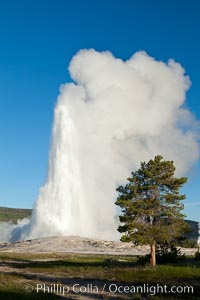
Old Faithful geyser, sunrise. Reaching up to 185' in height and lasting up to 5 minutes, Old Faithful geyser is the most famous geyser in the world and the first geyser in Yellowstone to be named.
Location: Upper Geyser Basin, Yellowstone National Park, Wyoming
Image ID: 26940
Location: Upper Geyser Basin, Yellowstone National Park, Wyoming
Image ID: 26940

Wildflowers on Mount Washburn, on the north side of Dunraven Pass near Tower Junction.
Species: Little sunflower, One-eyed sunflower, Helianthella uniflora
Location: Yellowstone National Park, Wyoming
Image ID: 26941
Species: Little sunflower, One-eyed sunflower, Helianthella uniflora
Location: Yellowstone National Park, Wyoming
Image ID: 26941

Steam rises at sunrise in Norris Geyser Basin. Located at the intersection of three tectonic faults, Norris Geyser Basin is the hottest and most active geothermal area in Yellowstone National Park.
Location: Norris Geyser Basin, Yellowstone National Park, Wyoming
Image ID: 26943
Location: Norris Geyser Basin, Yellowstone National Park, Wyoming
Image ID: 26943

Steam rises at sunrise in Norris Geyser Basin. Located at the intersection of three tectonic faults, Norris Geyser Basin is the hottest and most active geothermal area in Yellowstone National Park.
Location: Norris Geyser Basin, Yellowstone National Park, Wyoming
Image ID: 26944
Location: Norris Geyser Basin, Yellowstone National Park, Wyoming
Image ID: 26944

Gibbon River meanders through Gibbon Meadows, sunrise and clouds reflected in the calm waters.
Location: Gibbon Meadows, Yellowstone National Park, Wyoming
Image ID: 26946
Location: Gibbon Meadows, Yellowstone National Park, Wyoming
Image ID: 26946

Great Fountain geyser. Great Fountain geyser's large vent (16 feet across) sits amid wide sinter terraces that act as reflecting pools as the geyser slows fills prior to its eruption.
Location: Lower Geyser Basin, Yellowstone National Park, Wyoming
Image ID: 26948
Location: Lower Geyser Basin, Yellowstone National Park, Wyoming
Image ID: 26948
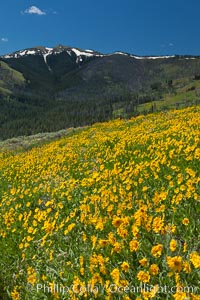
Wildflowers on Mount Washburn, on the north side of Dunraven Pass near Tower Junction.
Species: Little sunflower, One-eyed sunflower, Helianthella uniflora
Location: Yellowstone National Park, Wyoming
Image ID: 26950
Species: Little sunflower, One-eyed sunflower, Helianthella uniflora
Location: Yellowstone National Park, Wyoming
Image ID: 26950

Steam rises at sunrise in Norris Geyser Basin. Located at the intersection of three tectonic faults, Norris Geyser Basin is the hottest and most active geothermal area in Yellowstone National Park.
Location: Norris Geyser Basin, Yellowstone National Park, Wyoming
Image ID: 26951
Location: Norris Geyser Basin, Yellowstone National Park, Wyoming
Image ID: 26951

Steam rises at sunrise in Norris Geyser Basin. Located at the intersection of three tectonic faults, Norris Geyser Basin is the hottest and most active geothermal area in Yellowstone National Park.
Location: Norris Geyser Basin, Yellowstone National Park, Wyoming
Image ID: 26952
Location: Norris Geyser Basin, Yellowstone National Park, Wyoming
Image ID: 26952